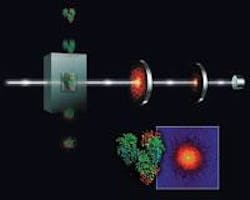Photon sciences continue expansion into the nano realm
In a keynote address describing a 1-km-long free-electron x-ray laser, Keith Hodgson, deputy director of the Stanford Linear Accelerator Center (SLAC), set an upbeat tone for this year’s annual meeting of the Stanford Photonics Research Center (SPRC; Palo Alto, CA). The Linac Coherent Light Source (LCLS) is scheduled to begin construction next year along the final third of the 3-km linear accelerator (Linac) at SLAC, and to achieve first light in 2009. It will combine laser and x-ray capabilities to yield brighter, more finely focused light at faster shutter speeds than current synchrotron or laser sources.
As with most of the topics discussed during the three-day meeting, the advances in fundamental science also translate into practical applications in areas such as the biological sciences, various nanosciences, and information sciences.
The LCLS will accelerate bunches of electrons through an undulator magnet, releasing x-rays with each direction change. The x-ray laser pulses will be emitted coherently, at a single wavelength and at pulse widths three orders of magnitude shorter than those from current synchrotron x-ray sources, to provide temporal resolution on the order of femtoseconds. Beam brightness will exceed the brightness capabilities of existing synchrotrons by about ten orders of magnitude because of self-amplified spontaneous emission, in which electromagnetic fields generated as electron bunches and radiated x-rays move through the undulator magnet and further amplify the number of emitted x‑ray photons. In addition, x-ray-photon wavelengths will yield spatial resolution on the order of angstroms.
“Photon science is the most rapidly expanding element in the changing balance of scientific foci at SLAC,” said Hodgson, who described the LCLS as a key element in that changing balance. “By 2010, no other laboratory in the world will have an equal ability to investigate both the ultrafast and the ultrasmall.” Potential applications range from creating and probing atomic plasmas to performing detailed “freeze-frame” photography of as-yet unobserved processes such as the making and breaking of molecular bonds in chemical reactions, and the inner workings of protein interactions, nanomachines, and quantum transitions (see figure).
Biophotonics
During an industry panel on biophotonics, Robert Filkins described work in the research and development arm of General Electric (GE; Fairfield, CT) on label-free detection and analysis of proteins to support GE’s three-year-old foray into machines and chemistry for drug discovery and manufacture. New sensors are required, Filkins said, to enable pharmaceutical manufacturers to tell the Food and Drug Administration not just that a drug works, but also how and why it works. Immune-system biologist Mark Davis discussed ongoing work at Stanford and elsewhere that includes taking motion pictures of T-cell interactions, which Davis described as “The Wild Kingdom at the cellular level.” And Thomas Huser described efforts at Lawrence Livermore National Laboratory (Livermore, CA) to develop probes for pathogen detection systems based either on “label detection or on labels that go beyond what current labels do.”
Biophotonics-research presentations also included a report by Mark Schnitzer on the development by his Stanford research team of a portable, palm-size two-photon microendoscope, measuring only 3.5 × 1.2 × 1.5 cm in size, with a mass of only 3.9 g, and providing micron-scale spatial resolution. Two-photon microscopy penetrates only about half a millimeter below the tissue surface, so the Stanford team combined two-photon imaging with microendoscopy by collecting image data through a 1-mm-diameter doublet gradient refractive-index (GRIN) lens endoscope probe that can be inserted into living tissue.
The two-photon fluorescence microendoscope consists of a DC micromotor for focusing, a flexible photonic-bandgap fiber for delivery of 100- to 150-fs, 790- to 810-nm excitation pulses from a Ti:sapphire laser, and a large-core multimode fiber for fluorescence collection. A piezoelectric actuator enables the device to scan the image field. Because of the wide availability of transgenic mice, device development has focused on scanning blood vessels in the brains of live mice, but Schnitzer expects the portable microendoscopy technique to eventually find much broader biomedical applications.1
Silicon photonics
From the information sciences perspective, Mario Paniccia, director of the photonics technology lab at Intel (Santa Clara, CA), discussed the potential role of silicon photonics in helping the semiconductor industry continue to uphold Moore’s Law. Exponential growth in computer speeds (instructions per second) during recent decades has been matched by similar rates of cost reduction, he said. And replacement of electrical interconnect technology with high-speed optical interconnects could facilitate ongoing exponential growth rates.
Developments at Intel and elsewhere, which include demonstration of optical modulators and continuous-wave lasers based on the Raman effect in silicon, might eventually help to keep costs decreasing as they have been. Existing CMOS manufacturing capabilities could enable silicon-based optoelectronics to extend high-speed optical interconnect technology from established telecom applications, on the order of meters and kilometers, to board-to-board and chip-to-chip computer applications, on the order of centimeters (see Laser Focus World, April 2005, p. 21). “By ‘siliconizing’ photonics, one could bring optical communications to the mass market,” Paniccia said.
REFERENCE
1. B.A. Flusberg et al., Optics Lett.30(17) 2272 (Sept. 1, 2005).
About the Author
Hassaun A. Jones-Bey
Senior Editor and Freelance Writer
Hassaun A. Jones-Bey was a senior editor and then freelance writer for Laser Focus World.
